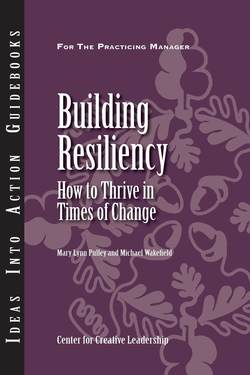Читать книгу Building Resiliency: How to Thrive in Times of Change - Mary Lynn Pulley - Страница 8
На сайте Литреса книга снята с продажи.
ОглавлениеWhat Is Resiliency?
Resiliency provides the ability to recover quickly from change, hardship, or misfortune. It’s associated with elasticity, buoyancy, and adaptation. Resilient people demonstrate flexibility, durability, an attitude of optimism, and openness to learning. A lack of resilience is signaled by burnout, fatigue, malaise, depression, defensiveness, and cynicism.
Resiliency is the product of a broad perspective. You can bolster it with a supportive network of professional and personal relationships, and use it to become comfortable with change. Resiliency taps into your ability to adapt even as it relies on your own knowledge about yourself – your values, confidence, and optimism. And it’s a key element to success on all levels and in all aspects of your life, from professional career development and leadership opportunities to the pursuit of personal goals and well-being.
People often have the view that resiliency means being unflappable, strong, or unaffected. Most of us have heard the saying, “When the going gets tough, the tough get going.” But resiliency isn’t simply a matter of “toughing it out.” Bearing up under pressure is certainly part of being resilient, but just one part. Marathon runners, for example, have to be tough to endure a grueling 26-mile run, and yet it’s often their ability to handle the intangibles (weather, unknown competition, attitude about ability, a slight but nagging injury at the 20-mile marker) that puts them across the finish line and in the winner’s circle.
Developing resiliency requires that you pay attention to the complexities of your experiences, listen to your emotions, and be willing to learn from disappointment as well as success.
A Tale of Resilience
Straight out of college, Matt began working for a national grocery chain. For 16 years, he did very well. Shortly after accepting a significant promotion, things began to change. Struggles with his new supervisor overshadowed his work for the next two years, whittling away at his confidence and job satisfaction. Eventually, his job was eliminated and he was laid off.
Matt did not rush immediately into a rigorous job search. “I did a lot of self-evaluation in terms of where I was and how marketable I was … I tried to step back and not rush into anything,” he says. He spent more time with his family and began getting involved in the community and with his church.
After a three-month break, Matt felt rejuvenated and began a diligent, focused process of networking and job searching. Through a series of contacts, he was offered a job in a related field. Over time, Matt began to see how much he learned from the loss of his job. On the work front, he realized he needed to do a better job of “managing up” – communicating with his boss and his boss’s boss. Personally, he learned that maintaining a more balanced life is an effective long-term way to cope with life’s ups and downs. After two years on the new job, he had grown his region’s business by 20 percent, while at the same time continuing his focus on family and community.
Matt believes losing his job was a blessing in disguise: “It was not a catastrophic event. There was a paradigm shift, but it wasn’t a catastrophe.”
